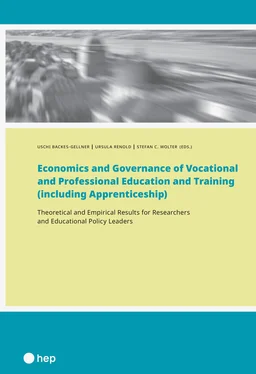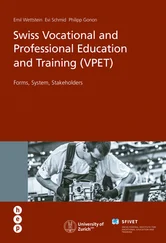It is obvious that education activities are very different in the USA and Switzerland. While young people completing such a nationally regulated VET program in system gastronomy at McDonald Switzerland can easily work for another company in the same sector, this is unlikely to be the case in the USA because there is no mandatory national, cross-company curriculum as a basis for training or education (see Lerman, 2010). The striking differences in this example also have to do with the length of the training. While in Switzerland, there is a three-year in-company training program combined with education in Vocational Schools according to a well-defined curriculum, the on-the-job training in the USA is not specified externally. Experience shows that such training usually lasts a few days to a few weeks. It is not so much a question of training the entire industry with highly qualified specialists but rather of a labor-market integration program with a short-term perspective that resembles the Adam Smith division of labor approach (Ryan, 2000).
Short-Term versus Long-Term Views
Smith and List obviously had different conceptions of political economy. In the short-term perspective, the classic model advocates “laissez faire” on the part of the state and suggests that a self-regulating economy based on short-term business creates the best conditions for wealth creation. In the long-term perspective, the Listian model emphasizes the “long-term development of factors underlying the production of values as a path to material prosperity over a historical epoch” (Winch, 1998, p. 369). According to Winch, Smith’s model was widely adopted in Anglo-Saxon countries, while List’s approach is applied in Germany, Switzerland, and Austria which are all countries that have a dual VET system.
In List’s view, VET includes all people who are necessary for the development of the work process. Unskilled workers have no ability to develop new products and are separated from the production process. These workers do not have an occupational tradition that is handed down over generations. He concluded:
Without a long-term perspective there are no incentives to upgrade skills or to nurture trades and crafts. (…) They need to retain their social and educational element and develop it in relationships with schools and colleges. The development of secondary technical education can then be associated with local and regional industries and with individual firms within the region in order to ensure a steady supply of skilled personnel to the industries and, hopefully, a supply of teachers to the schools and colleges. (List, 1991, pp. 200–201)
Governance and Configuration of National Institutions
List placed the development of production forces at the center of economic interest and emphasized the long-term and future-oriented process. Furthermore, List placed the importance of social processes at the center of his argumentation, which requires state planning, institutions, and development under changed conditions. To increase productivity, the general education and qualification level of the population must be improved. The balance of skills must grow with the level of economic development.
Therefore, public funding of key elements of the education system is necessary for List . This funding would include all those elements that are unlikely to be provided by the market, including elementary and secondary schooling, institutions that mediate between education and work (such as the German Berufschulen), technical institutes, and scientific universities (List, 1991, pp. 81–82, in: Winch, 1998, p. 375).
List came to the conclusion that general education and on-the-job training (OJT) must be combined .
More advanced forms of production are likely to require relatively high levels of literacy, numeracy, and general knowledge. But trade-specific skills and attitudes are only learned properly in the workplace. Therefore, VET needs to combine the two in a system such as the German “dual system.” (List, 1991, pp. 200–201, in: Winch, 1998, p. 376)
This approach of combining OJT with general education contrasts with most educational concepts in the Anglo-Saxon area nowadays. The latter usually have separate subsystems. On the one hand, Anglo-Saxon areas have full-time general education or VET schools, which are part of the education system; on the other hand, they have subsequently organized labor-market integration programs, which are controlled by the employment authority and do not lead to a formal education qualification (Lerman, 2010; Ryan, 2000).
Finally, Winch (1998) pointed out that the approach proposed by List poses a greater challenge to governance. “What is most difficult to replicate, namely the density and complexity of institutions required to co-ordinate education and training: government, unions, employees, educational institutions of various kinds” (p. 377). Winch concluded that the Listian VET approach arises from the cultural and economic roots of society and cannot simply be imposed by a government. Without robust social institutions based on functional equivalences and a robust interplay of those social institutions, it will be very difficult to attain similar results (Renold et al., 2019). The comparison of the two economic perspectives shows differences in the framework conditions under which a political economy should be organized. Winch highlighted the consequences of such differences for the development of VET.
Therefore the changing of a VET system, similar to the changing of an education system more generally, is dependent upon and has ramifications throughout society and politics. It cannot be a simple matter of a technical recipe to aid economic growth, but touches on the heart of what any society is about. (Winch, 1998, p. 377)
2.3.2 Concept of Variety of Capitalism (VoC)
The second subsection addresses the configuration of national institutions in the economic context and has an impact on VET approaches, which are associated with the concept of the variety of capitalism . In political science, the concept of the variety of capitalism emerged in the late 1990s (e.g., Finegold & Soskice, 1988; Culpepper, 1999; Hall & Soskice, 2001; Hancké et al., 2007; Hall & Gingerich, 2009; Busemeyer, 2009). Essentially, these authors are aligned with Smith and List’s historic dogma and have identified ideal types that also provide clues as to why countries organize VET programs so differently.
The two ideal types are coordinated (CME) or liberal (LME) market economies, which are determined according to national institutional configurations. CMEs are embedded in a variety of intermediary institutions. As an example, companies coordinate among themselves; they conduct wage negotiations at the national level, and they generally tend to focus on long-term strategies. “The training systems of CMEs typically provide high skill levels and the requisite mix of company-specific and more general technical skills” (Hall & Soskice, 2001, p. 40). LMEs are based less on mediating collective institutions than on market forces to solve coordination problems and do not engage in collective wage bargaining and have little worker protection.
From the perspective of workers facing short job tenures and fluid labor markets, career success also depends on acquiring the general skills that can be used in many different firms; and most educational programs from secondary through university levels, even in business and engineering, stress ‘certification’ in general skills rather than the acquisition of more specialized competencies. (Hall & Soskice, 2001, p. 30)
Hence, such socioeconomic and sociocultural differences may have an influence on the social constructedness of VET programs.
Читать дальше












